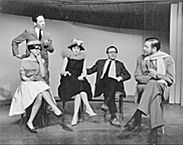| Entries |
| A |
|
Acting, Ensemble
|

|
In the 1970s and 1980s, resident ensemble companies came to the fore. Stuart Gordon's Organic Theater became known for inventive ensemble-driven pieces like Warp and Bleacher Bums. In 1974, the Goodman Theatre established Stage 2, a program that supported the collaboration of playwright David Mamet and director Gregory Mosher. Mamet associates William H. Macy, Joe Mantegna, and Lindsay Crouse often performed in Chicago premieres of both local and national productions of Mamet's plays and, later, in Mamet's films. By 1985, Mosher had established the New Theatre Company, consisting of a resident ensemble of actors, playwrights, and designers that produced new plays in both the Goodman Studio and the Briar Street Theatre. But the company immediately folded when Mosher was tapped to run the Lincoln Center Theater in New York. Robert Falls, who had been artistic director of Wisdom Bridge Theatre, inaugurated in 1986 a new kind of ensemble at the Goodman. Falls quickly assembled a directorial triumvirate consisting of himself, Frank Galati, and Michael Maggio in a partnership modeled on one Falls had observed at the National Theatre in London. Whereas Steppenwolf, which featured such actors as John Malkovich, Gary Sinise, Joan Allen, and Laurie Metcalf, was an actor's ensemble in which directing was less crucial to the process than visionary, visceral acting, Falls created a director's ensemble in which the passions of individual directors drove play selection and production concepts. Falls's vision evolved in the 1990s with the addition of such artists as Mary Zimmerman, Henry Godinez, and Regina Taylor to the Goodman artistic roster. Zimmerman, a uniquely gifted director/adaptor of major works of world literature to the stage, did her earliest ensemble work with the Lookinglass Theatre ensemble, which has established its own prominence in the Chicago theater scene. Zimmerman's commitment to ensemble has extended to her casting process: at her auditions she observes multiple actors interacting at once, with special attention to each actor's physical capabilities. Her production of Ovid's Metamorphoses went from Chicago's Ivanhoe Theatre to Broadway in 2002, displaying to a larger audience a prime example of Chicago ensemble work.
The Encyclopedia of Chicago © 2004 The Newberry Library. All Rights Reserved. Portions are copyrighted by other institutions and individuals. Additional information on copyright and permissions.